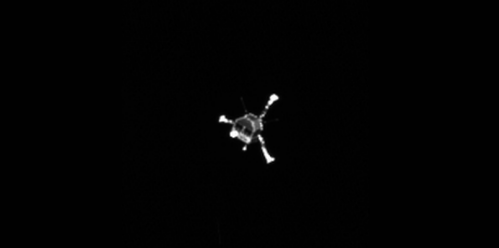Scientists will try to contact the Philae comet lander on March 12

Scientists from the German Aerospace Center (DLR) will make the first attempt to contact the stranded comet lander Philae on Thursday Mar. 12. "The first attempt will take place already this week, on March 12," Stephan Ulamec, Lander Project Manager at DLR, told astrowatch.net. If we're lucky, the first signal will be received by ESA's Rosetta spacecraft at 05:00 CET. Philae came to rest on Nov. 12 2014 in a rather shaded location on Comet 67P/Churyumov-Gerasimenko and it needs to receive sufficient energy before it can wake up.
Several conditions must be met for Philae to start operating again. First, the interior of the lander must be at least at –45ºC before Philae can wake up from its winter sleep. At its new landing site – Abydos – only a little sunlight reaches Philae, and the temperatures are significantly lower than at the originally planned landing location. The lander must also be able to generate at least 5.5 watts using its solar panels to wake up.
Ulamec believes that even better opportunity to restore the communication with the lander will come in May. "I think we do have a fair chance to get contact with the lander again. I do see it more likely though, to have Philae re-activated around May, when comet and lander are closer to the sun," he said.
Once awakened, Philae will switch on its receiver every 30 minutes and will listen for a signal from the Rosetta spacecraft.
Philae needs a total of 19 watts to begin operating and allow two-way communication. It could be that the lander has already woken up from its winter sleep some 500 million kilometers away from Earth, but does not yet have sufficient power to communicate with Rosetta.
Ulamec hopes that if the lander wakes up, it will still be able to conduct scientific experiments. "This depends on the power and energy available. First, we will have to be modest and conduct temperature measurements etc. If it is possible to re-charge the battery, more demanding activities, like another attempt to take samples or another radar-scan, could be performed," he revealed.
Before the contact was lost with Philae, it has managed to deliver a lot of significant scientific data. "After the separation about 16.2 MB of data have been downloaded from Philae to Earth. There is lots of science in those, like 7 usable panorama images!" Ulamec said.
So far, Philae's exact location has not been identified on images acquired by the Rosetta orbiter, so the operations team at DLR is currently working with the information they have from the lander's cameras, along with the knowledge gained from the solar energy conditions experienced in November.
Source: Astrowatch.net





















